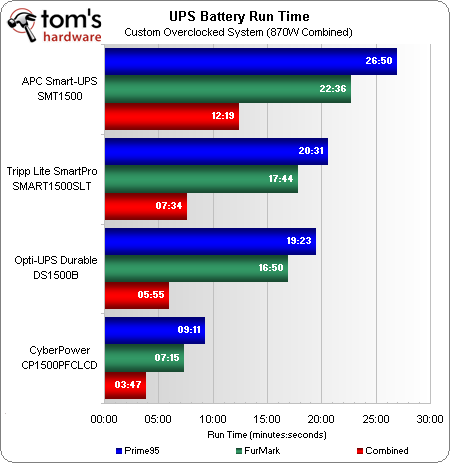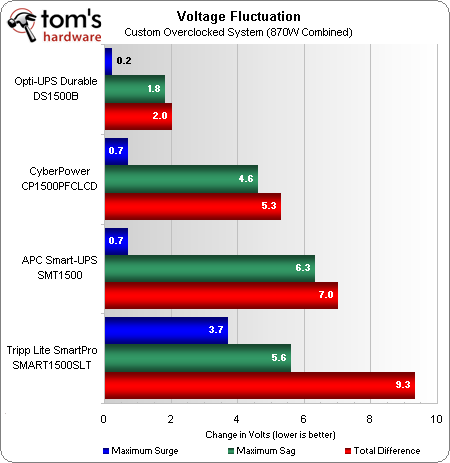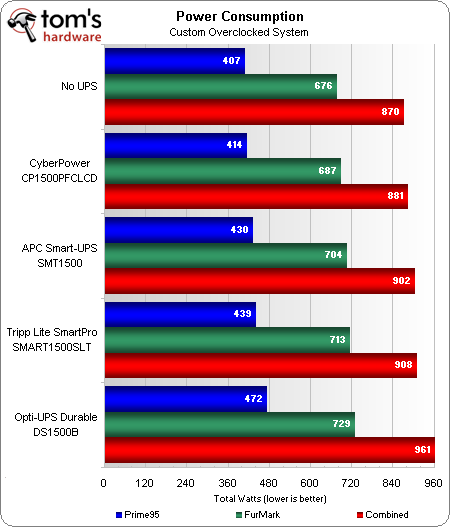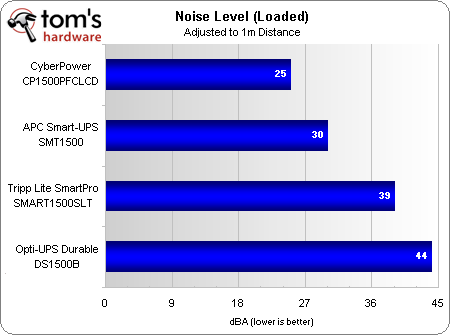Enthusiast Power Protection: Four-Way 900 W UPS Roundup
It's downright negligent to ignore the power needs of your high-end hardware. While many power users go to the trouble of tracking down solid PSUs, we recommend going a step further and investing in battery backup. We round up four enthusiast units.
Benchmark Results
An ideal comparison might show run time versus cost using UPS devices with similar features, but competing feature sets makes that type of comparison impossible. Features often cost more than upsized batteries, so run time is only a single component of today’s multi-faceted test.
Lead-acid batteries are super-reliable and super-heavy, so it makes sense that our runtime chart is a reflection of unit weight. But how do these compare in power protection?
Opti-UPS provided the only UPS with double-conversion topology, which means that all of the unit's output power is filtered through the batteries first. That technique produces superior protection against surges and brown-outs, but at higher cost. The results of line-interactive units are a reflection of their default sensitivity settings, where user-adjustable increased sensitivity could reduce battery life.
Converting 100% of line-input power to battery power, then converting it back to line-output power is a somewhat inefficient process. The double-conversion unit from Opti-UPS thus falls to the bottom of the power consumption chart, which is probably a small sacrifice in exchange for the unit's improved protection.
CyberPower and APC use thermally-controlled fans, never getting hot enough to kick up to high speed even when placed under the extreme loads of an enthusiast-class PC. Either of these units is sufficiently quiet for use in an office environment, where they’d normally be placed at least twice the standard one-meter listening distance from the user.
Tripp Lite’s noise resembles that of a white-noise generator, which is soothing to some people. We’d still recommend placing it at least four meters from your chair.
The Opti-UPS DS1500B’s cooling fan runs at full-speed, full time, just like Tripp Lite's. Its higher noise likely reflects the higher heat generated by its more protective double-conversion design, yet the pitch of its noise is such that we’d reserve this unit for a server closet.
Get Tom's Hardware's best news and in-depth reviews, straight to your inbox.
CyberPower exhibits amazing power efficiency, consuming around 1% more energy than the unprotected system. Opti-UPS’ double-conversion design requires more power to provide more protection.
-
sudeshc Have been using APC for last 2 years now without any issues what so ever.Reply
Would recommend it although they might be a bit costly but they perform really well. -
hmp_goose Soooo you have nothing to say about the TripLite atoll? Dead last? Distant second? Muddled mess? Nice part for not-our-application?Reply -
dEAne I have several units of APC and a hundred after-sales issues which remains unanswered, I opted to installed the generator set and a AVR than a UPS.Reply -
Emperus Most folks would just be happy to ignore on the need for a backup power source.. Hope this article enlightens them on getting one to protect their precious components and/or be ready if and when the situation arises.. Would be great if Tom's could put up a tier based classification on suitable UPS choices for various PC's (gaming, server, home theatre etc.)..Reply -
super_tycoon What about AVR? (Automatic Voltage Regulation) I have a CP1500AVRLCD and I've seen (at least I'm pretty sure) I've seen the AVR feature kick in when one of the local power lines got knocked out and the voltage drooped to ~100. (killed some of my non-dimmable cfl's) I went to CP's website and it claimed the pfc units still have AVR functionality. So here comes the confusion, what's the point of the voltage tolerances? If it has an AVR, why would it matter what voltage it's fed as long as there steps on the transformer? I thought the unit was supposed to take 90-140 without having to engage the battery while still passing ~120v?Reply
You've also made me want to test my non-pfc ups with my 850hx, but my gaming rig and my workstation are an hour apart.... -
aldaia This is a quite inefficient & expensive approach to the problem. We take AC and use a transformer to convert to DC and store in a battery, meanwhile another transformer is also taking AC and converting to DC to feed our components. When there is a blackout, we take DC from the battery, convert to AC and feed the computer PS where we convert back to DC to feed our components. Wouldn't be more cost effective and energy efficient to use the same unit to both feed our components with DC and the battery? Most of the time a PS has a surplus of power that can be used to charge the battery. When there is a blackout we could just take DC from battery and feed our components without the inefficient double DC->AC->DC conversion. I think an integrated UPS/PS would be cheaper (most components are replicated). That would be enough for most enthusiasts, that only need a relatively short battery life to be able to save work. A different matter is in professional environments where a UPS feeds dozens of computers that cannot be stopped. ¿Anyone knows if such a think exists?Reply -
wrxchris I've been using a CyberPower 1350AVR for the past couple years and it has been great. Gives me approx. 17 mins of runtime at idle / basic tasks (approx. 250 watts between my rig and main LCD). It's good for 810W, and I believe I picked it up on sale for $120.Reply -
g00ey I've always been wondering about the possibilities to replace the small batteries in those UPSes with standard car batteries or deep cycle (marine) batteries. Since the batteries in the UPSes are standard 12V lead cells it shouldn't be a problem and this would be a cheap way to keep the computer alive for days without external power.Reply -
nebun g00eyI've always been wondering about the possibilities to replace the small batteries in those UPSes with standard car batteries or deep cycle (marine) batteries. Since the batteries in the UPSes are standard 12V lead cells it shouldn't be a problem and this would be a cheap way to keep the computer alive for days without external power.wrongReply





